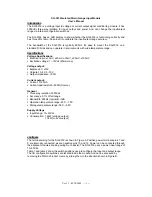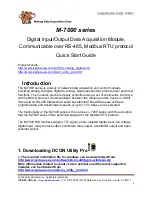
3-256
UR FAMILY – COMMUNICATIONS GUIDE
E3-2.0 IMPLEMENTATION MODEL FOR GOOSE CONFIGURATION VIA SCL
CHAPTER 3: IEC 61850 COMMUNICATION
3
The number of GOOSE messages that can be subscribed to, and thus the number of LGOS logical nodes, is product-
specific, and as such is specified elsewhere. Similarly, the maximum number of members that are allowed in a message is
specified elsewhere.
3.11.4 CID files
A CID file is generated by modifying the configured values in an ICD or IID file, and otherwise keeping the ICD file/IID file as
is. Both the G2 model ExtRef elements and the E3-2.0 LGOS data objects are retained in CID files.
E3-2.0 model configuration is assumed when only one IED element is present in the CID file.
The E3-2.0 GOOSE configuration consists of configuring the following LGOS settings for each GOOSE message that is to be
subscribed to.
Unlike the G2 model wherein ORG data objects throughout the information model can reference an external data attribute,
causing a GOOSE association to automatically form, under E3-2.0 external references are not allowed other than in
LGOS#.GoCBRef and LGOS#.GoDatSetRef. Also, under E3-2.0 the GGIO3.Inputs.ExtRef are not allowed to be configured.
Conversely, under G2, the LGOS#.InRef data objects used for E3-2.0 are not allowed to be configured. UR 7.30 and later do
not accept CID files that violate these rules.
The GoCBRef setting is used by both G2 and E3-2.0 models. Otherwise, only when the UR or UR Setup software detects that
the E3-2.0 model was used for configuration are the other settings outlined here used.
GoCBRef
An empty string indicates that the LGOS is spare, and subscribes to no message. Otherwise, the setSrcRef data attribute
is configured to an ACSI ObjectReference according to IEC 61850-7-2 clause 6.1.2.3 referencing the publishing GOOSE
control block, except that if the publishing logical device uses function-related naming (that is, its LDevice element
contains an ldName attribute), the LDName portion of the reference must use the value of ldName. Only GOOSE
messages with the corresponding MMS Object Name in the gocbRef field are accepted.
MAC
The setVal data attribute is configured to a six-octet hyphen-separated string (for example, 01-0C-CD-01-00-00). Only
GOOSE messages with this value of the Destination MAC address field are accepted.
APPID
The setVal data attribute is configured to an integer number from 0 through 65535. If the configured value is not zero,
only GOOSE messages with the configured value in the APPID field are accepted. If the configured value is zero, any
value in the APPID field is acceptable.
GoDatSetRef
The setSrcRef data attribute is configured to an ACSI ObjectReference according to IEC 61850-7-2 clause 6.1.2.3
referencing the publishing dataset, except that if the publishing logical device uses function-related naming (that is, its
LDevice element contains an ldName attribute), the LDName portion of the reference must use the value of ldName.
Alternatively, the setSrcRef data attribute can be configured to the empty string. If the configured value is not the empty
string, only GOOSE messages with the corresponding MMS Object Name in the datSet field are accepted. If the
configured value is the empty string, any value in the datSet field is acceptable.
GoID
The setVal data attribute is configured to a VisibleString with a maximum size of 129 octets. If the configured value is not
the empty string, only GOOSE messages with the corresponding string in the goID field are accepted. If the configured
value is the empty string, any value in the goID field is acceptable.
GoID
VSG
Identification for the GOOSE message
ConfRev
ING
GOOSE configuration revision number
InRef
δδ
ORG
Data attribute intAddr specifies the intermediate data object receiving values in allData member
δδ
. Note that
δδ
is a number from 1 through to the maximum number of members the IED is
capable of subscribing to using this LGOS.
LGOS class for E3-2.0
Data object
name
Common data
class
Explanation
T
















































